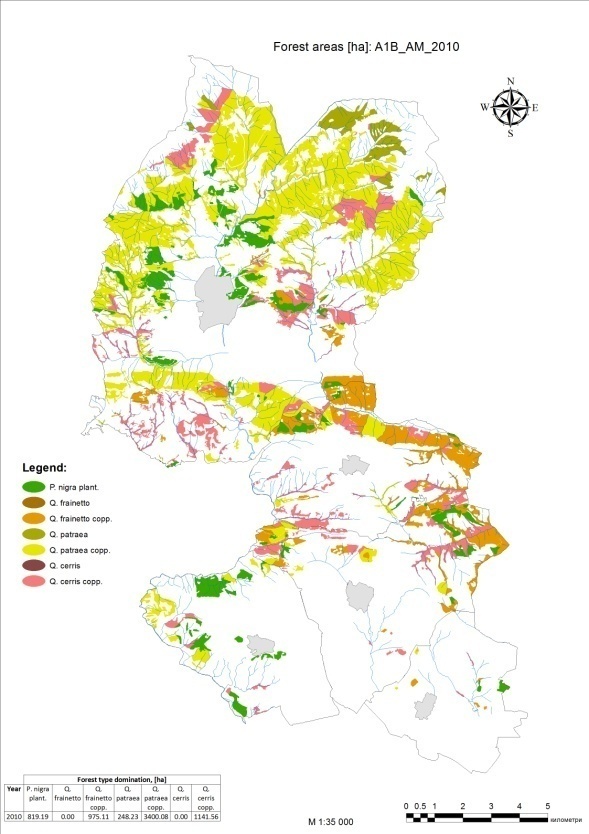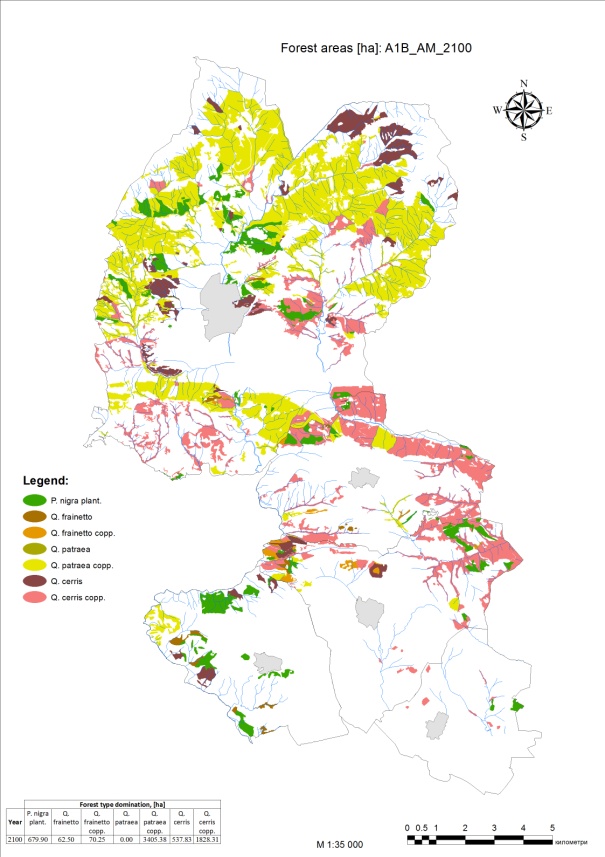There are few options available to adapt the forest management in the Panagyurishte to a changing climate.
One is to support the increasing of the share of more drought tolerant species as Turkey oak, despite the less valuable timber production of it.
Another potential measure is to implement more intensive regeneration treatments on mature coppice stands. This would respond to two important management goals – to convert coppice oaks stands in to high ones and to establish young, high forests stands, which theoretically would be more flexible to environmental changes.
From the other side, the competition of new stumping sprouts after the regeneration felling is an important ecological and economic obstacle, which might frustrate the transformation. We may expect that more stands in the future will own mixed origin. The problem with the total timber productivity of the future stands should not be underestimated as well.
Reducing the fire risk means more intensive thinning, as well as diminishing the share of pure conifer plantations. These measures could meet some economic obstacles, since many of them are not profitable.
Finally, the strictly even age structure of the current existing stands favors its occurrence again in to next generations. Generally pure, even age stands with simple (homogeneous) spatial structure are less resilient to different stress factors. The establishing of a more heterogeneous stands structure needs longer time and additional financial and human resources, which will reduce the implementation of these treatments.
The adaptive management scenario (AM) includes silvicultural treatments which are convenient, well-known and possible according to both the expert opinions and legal management conceptions. They include shortening the rotation age of the coppice stands for conversion in to high and relatively intensive tending and thinning in to young stands.

Fig. BG-11. Species and origin dynamics of forest stands in case study Panagyuristhe by moderate climate scenario A1B and AM management (2010)

Fig. BG-12. Species and origin dynamics of forest stands in case study Panagyuristhe by moderate climate scenario A1B and AM management (2100)
What do the AM projections predict about?
- Tree species composition and stands origin;
- Stands growth and potential timber harvest;
- Volume stock per hectare of the stands.
Tree species composition and stands origin: In all climate scenarios, adaptive management scenarios determine higher share of high forests in the case study area in comparison with current practice (BAU). More intensive regeneration felling according to AM will lead to increasing the areas of young stands dominated by trees of seed origin in short to mid-term outlooks. Long-term projections predict back-turn to coppice dominate origin of the existing stands. The share of the most adaptive Turkey oak increase faster in short-term run replacing more often Sessile oak and pine. Important conclusion of the long-term projection is that the conception of total conversion of the coppice oak stands will not be fulfilled, never than the less AM scenario promotes higher future share of high forests, than BAU.
Stands growth and potential timber harvest: Potential timber harvest will decrease during the projection time, since the main annual increment decreases for both AM and BAU scenarios and both coppice and high stands. AM management require urgent, short-term harvest in all coppice stands, which will decrease considerably after 2020. This rises the potential problem concerning the lack of ability of the stands to supply the timber demand in mid and long-term outlook, if assumed that it will keep the current level. From the other hand the risk of men-caused fires will diminish since less human activities will be possible in more dense young forests.
Volume stock per hectare of the stands: AM promotes the relatively intensive and steady decrease of the standing volume per hectare of the existing forests in short and middle term period for all stands. This connects to the more intensive regeneration felling in the short-term run for oaks stands. The total area of the pure pine stand decreases since native species (oaks) become dominants. In the long term perspective the AM scenario supports higher volume stock in comparison with the BAU for all oaks stands. The projections represent volume per hectare in the end of the century equal to the current one. In a few words, the AM promotes ability of the future coppice oaks stands to produce and support aboveground biomass, like coppice forest today. This mean that the stands will be similar to the current ones and will consist from closed forests and they could guarantee their protective and other environmental services, despite the low timber production and supply.
see also this FAQ (especially the figures).
For a summary of the results and differences between the AM and the BAU scenarios see Table BG-3.
Table BG-3.Comparison between the AM and the BAU management concerning legal management goals, related to different forest ecosystem functions in the Panagyurishte case-study (+ positive impacts, – negative impacts, ~ indifferent).
| Management goals |
2010-2020 |
2020-2050 |
2050-2100 |
|||
| Management scenario |
AM |
BAU |
AM |
BAU |
AM |
BAU |
| Conversion the coppice to high |
++ |
+ |
~ |
+ |
– |
–– |
| Production of construction timber |
+ |
~ |
– |
– |
— |
— |
| Fuel-wood supply |
+ |
~ |
~ |
– |
— |
— |
| Protection of erosion |
~ |
~ |
– |
— |
+ |
~ |
| Landscape improving, recreation |
~ |
~ |
– |
~ |
+ |
– |
| Source of clean air |
~ |
~ |
– |
– |
+ |
~ |
Some additional conclusions:
The AM scenario provides higher species diversity and performs a steady share of coniferous;
No significant differences in BAU and AM in terms of yield, growth and other stand characteristics (density, composition, origin) are observed;
The potential room for adaptation in terms of traditional silvicultural aims for all coppice forests is narrow;
The AM scenario moderates potential harm concerning timber supply and forest diversity;
These should lead to changes in long-term goals and traditional expectations from these forests.